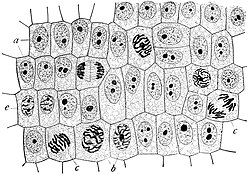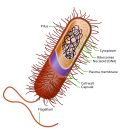Histone-like nucleoid-structuring protein (H-NS), is one of twelve nucleoid-associated proteins (NAPs) whose main function is the organization of genetic...
14 KB (1,674 words) - 20:59, 18 March 2025
is as yet unclear. A distinguishable feature of histone-like or heat-stable nucleoid structuring protein (H-NS) from other NAPs is the ability to switch...
152 KB (17,310 words) - 21:17, 12 June 2025
discovered, including the regulation of gene expression by histone-like nucleoid-structuring protein, H-NS. H-NS is about 15.6 kDa and assists in the regulation...
19 KB (2,263 words) - 01:58, 11 December 2023
(ed.). "Silver Ions Caused Faster Diffusive Dynamics of Histone-Like Nucleoid-Structuring Proteins in Live Bacteria". Applied and Environmental Microbiology...
17 KB (2,003 words) - 20:21, 20 May 2025
Molecular evolution (redirect from Protein evolution)
and/or RNA change over evolutionary time, and the consequences of this for proteins and other components of cells and organisms. Molecular evolution is the...
36 KB (3,921 words) - 10:31, 25 May 2025
to a complex of small basic proteins called histones. In prokaryotes, multiple types of proteins are involved. The histones form a disk-shaped complex...
22 KB (2,637 words) - 06:01, 3 April 2025
Gene family (section Basic structure)
Knowing the sequence of the protein encoded by a gene can allow researchers to apply methods that find similarities among protein sequences that provide more...
16 KB (2,025 words) - 21:21, 18 November 2024
Sequence homology is the biological homology between DNA, RNA, or protein sequences, defined in terms of shared ancestry in the evolutionary history of...
41 KB (4,481 words) - 18:35, 16 July 2025
protein is the open reading frame 1 on the LEE1 operon. The mechanism of Ler regulation involves competition with histone-like nucleoid structuring protein...
9 KB (1,101 words) - 14:36, 7 July 2024
Chromosome condensation (section Histones)
Although bacteria lack histones, their genomic DNA associates with various nucleoid-associated proteins (NAPs) to form the nucleoid, a functional counterpart...
52 KB (5,885 words) - 11:24, 18 July 2025
DNA (redirect from Protein-DNA complex)
chromatin proteins, such as histones, compact and organize DNA. These compacting structures guide the interactions between DNA and other proteins, helping...
168 KB (18,024 words) - 18:52, 29 July 2025
Chromatin (redirect from Chromatin structure)
primary protein components of chromatin are histones. An octamer of two sets of four histone cores (Histone H2A, Histone H2B, Histone H3, and Histone H4)...
54 KB (6,007 words) - 03:59, 15 July 2025
Bacterial DNA is packed with the help of polyamines and proteins called nucleoid-associated proteins. Protein-associated DNA occupies about 1/4 of the intracellular...
17 KB (2,085 words) - 20:29, 17 July 2025
nucleoid Extrachromosomal DNA, located outside of the nucleoid region as circular or linear plasmids The bacterial DNA is not packaged using histones...
36 KB (4,598 words) - 06:19, 6 June 2025
"Detection and localization of a chloroplast-encoded HU-like protein that organizes chloroplast nucleoids". The Plant Cell. 14 (7): 1579–89. Bibcode:2002PlanC...
193 KB (19,627 words) - 02:33, 25 July 2025
Cell (biology) (section Protein synthesis)
more linear molecules, called chromosomes, which are associated with histone proteins. All chromosomal DNA is stored in the cell nucleus, separated from...
59 KB (6,194 words) - 19:59, 1 August 2025
Chromosome (section Structure in sequences)
packaging proteins; in eukaryotic cells, the most important of these proteins are the histones. Aided by chaperone proteins, the histones bind to and...
64 KB (6,606 words) - 07:28, 31 July 2025
Prokaryote (section Structure)
The genome in a prokaryote is held within a DNA/protein complex in the cytosol called the nucleoid, which lacks a nuclear envelope. The complex contains...
45 KB (4,328 words) - 23:47, 22 July 2025
their main structure is made of proteins. Such cell structures include: large RNA and protein complexes: ribosome, spliceosome, vault large protein complexes:...
28 KB (2,303 words) - 10:39, 18 July 2025
Chloroplast DNA (section Nucleoids)
Though chloroplast DNA is not associated with true histones, in red algae, a histone-like chloroplast protein (HC) coded by the chloroplast DNA that tightly...
55 KB (5,909 words) - 16:54, 16 July 2025
thermoacidophilic archaea. Instead of using histones, a type of protein called nucleoid associated proteins (NAPs) are expressed, however the degree of...
18 KB (2,027 words) - 17:15, 28 May 2025
including down-regulation of certain nuclear proteins, increased DNA damage, and demethylation of histone, leading to reduced heterochromatin. Nematodes...
61 KB (6,330 words) - 23:57, 28 July 2025
Cell nucleus (redirect from Nuclear proteins)
dotted with various proteins, such as histones, that protect and organize the DNA. The genes within these chromosomes are structured in such a way to promote...
88 KB (10,011 words) - 23:05, 23 June 2025
HdeA family (category Protein domains)
biology, the HdeA family of proteins (HNS (histone-like nucleoid structuring)-dependent expression A) is a stress response protein family found in highly acid...
2 KB (246 words) - 06:36, 2 October 2024
prokaryotic organisms do not possess a membrane-bound nucleus like eukaryotes, they do contain a nucleoid region in which the main chromosome is found. Extrachromosomal...
55 KB (5,351 words) - 07:51, 19 July 2025
Condensin (category Protein complexes)
Condensin-like protein complexes also exist in prokaryotes, where they contribute to the organization and segregation of chromosomes (nucleoids). The best-studied...
100 KB (11,490 words) - 23:05, 22 July 2025
replication. Bound to ATP, and with the assistance of bacterial histone-like proteins [HU] DnaA then unwinds an AT-rich region near the left boundary...
21 KB (2,745 words) - 08:39, 17 November 2024
Telomerase reverse transcriptase (category Telomere-binding proteins)
of tri-methylated histones H3K9 and H4K20 at telomeres, as well as an increased detectable amount of TERT transcripts and protein activity. Without the...
46 KB (5,306 words) - 18:33, 17 July 2025
copies, and is also tightly associated with a number of proteins to form a complex known as the nucleoid. Inside mitochondria, reactive oxygen species (ROS)...
132 KB (16,142 words) - 16:06, 11 June 2025
target genes' production of the proteins they direct to be made (see Gene expression). In addition, TET2 binds to two histone deacetylases, HDAC1 and HDAC2...
85 KB (10,196 words) - 13:19, 9 June 2025






















